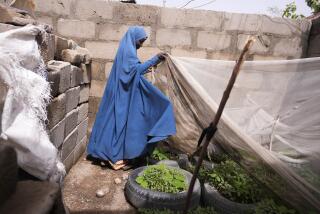Hunger breeds violence
Every day we wake up to headlines and images of devastating violence in hot spots around the globe. In Pakistan, for example, attacks over the last few weeks have killed scores and seriously injured many more. But beneath the headlines, there is another great challenge that is often the root cause of violence or its unintended consequences: increasing rates of hunger and an alarming lack of food.
One of the recent attacks in Pakistan struck the U.N. World Food Program office in Islamabad. Five employees carrying out their humanitarian mission were killed and several others were critically wounded in a suicide bombing. This program works to feed 10 million Pakistanis, 2 million of whom were displaced by fighting.
Today, on World Food Day, we must understand that hunger and conflict go hand in hand. Millions of people in poor countries suffer the burden. In 2008, protests over high food prices swept the globe. In Haiti, demonstrations turned into violent riots, killing many and causing widespread looting.
These explosions are no surprise. Empty stomachs breed panic and desperation, while extremist groups -- such as the one in Pakistan that carried out the recent attacks -- use food to advance their violent missions while undercutting security.
This year, Somalia and Sudan made headlines for similar turmoil. In Darfur, Sudan, one of the world’s largest humanitarian crises has left nearly 4 million conflict victims looking to international relief organizations for assistance. In addition to forcing people from their homes, Darfur’s conflict has destroyed the economy and prevented millions of children from completing their education, ensuring that Sudan remains one of the world’s poorest and most dangerous places. Humanitarian workers risk danger on a daily basis. The World Food Program has had its trucks hijacked and its drivers kidnapped or killed. In Somalia, where 3.6 million people require food aid daily, fighting keeps more than 1.5 million people homeless with no means to support themselves or their children.
A crucial element to fighting conflict in poor countries is to ensure adequate food, proper nutrition and access to education. School meals programs promote education and nutrition by giving hungry schoolchildren at least one meal a day. Once children start eating a healthy meal, schools report remarkable increases in enrollment, attendance and academic performance, and they are less vulnerable to recruitment by rebel forces.
For girls, the transformation changes lives and breaks the cycle of poverty. When they are properly nourished and educated, women marry later and have fewer children. Their children are healthier and better educated.
The meals programs also promote human rights, helping thwart trafficking and child labor. They address chronic hunger and offer such key interventions as deworming, vitamin A tablets and education about HIV/AIDS and sanitary standards. The programs even give some students food rations to help feed their families. The promise of food makes parents more inclined to send their children to school and ensure they complete their education.
Children who grow up in the world’s poorest countries know hunger as an everyday part of life. The U.N.’s Food and Agriculture Organization estimates that every six seconds a child dies of hunger. Those who don’t die face a childhood of worry and desperation -- a never-ending empty stomach. Many of them end up foraging in the streets or garbage heaps, where they are prime targets for recruitment by extremist groups or other criminal organizations. That is simply not acceptable when most live in a world of plenty.
Ensuring that no child goes to school hungry is the single greatest investment we can make in building prosperous, healthy and stable societies. The United States and other developed nations must make nutrition a requirement in peacemaking strategies.
More to Read
Sign up for Essential California
The most important California stories and recommendations in your inbox every morning.
You may occasionally receive promotional content from the Los Angeles Times.










